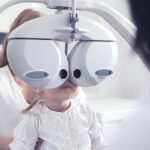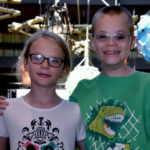Help your child prevent myopia with two simple steps

Myopia — also known as nearsightedness, or the inability to see things far away — is becoming more prevalent in children.
Although myopia can be triggered by genetics, it can also develop because of environmental factors such as limited time spent outdoors and increased time indoors doing activities such as activities on electronics. Dr. Kimberley Chan, an optometrist in Boston Children’s Department of Ophthalmology, has hope that despite projections such as half the world’s population will be nearsighted by 2050, myopia can be prevented.
Dr. Chan comes from a family of dentists, and she believes their profession’s emphasis on children developing strong dental hygiene habits can be applied to eye health. Just as parents guide their children with regular toothbrushing and flossing, they should help their children get familiar with eye-friendly habits early in life, she says. The formative years from birth to age 6 will determine the shape of their eyes and could lessen their chances of having myopia.
A child’s eye naturally grows; too much growth can cause myopia
Most people are born farsighted, but as a child grows, their eyes elongate to match the optical components of the eye. This allows images to meet directly on the retina, creating what would be considered normal vision. If elongation continues and overshoots, the images converge in front of the retina. That’s myopia.
A child is more at risk of developing myopia if their parents have it. But studies show that spending limited time outdoors also puts children at increased risk for developing nearsightedness. When people are exposed to brighter lights outdoors, the brain increases its release of dopamine — a chemical that sends messages to nerve cells throughout the body. A proper amount of dopamine to the retina will slow elongation of the eye.
Get kids outdoors and limit excessive near-work
The things that children do indoors are also connected to an increased risk of myopia, Dr. Chan says. At home and in school, kids do a lot of reading, writing, and other activities that require focusing on an object within arm’s reach. This near-work has been associated with nearsightedness, but optometrists would never discourage learning or fun for the sake of preventing myopia, she says. Instead, parents can help their children do near-work and practice a good eye health routine with two simple steps:
Take breaks from near-work
Breaks from learning on electronics — or even reading printed books — could be helpful. The American Academy of Ophthalmology recommends that after 20 minutes of near-work on a digital screen, children should look at an object 20 feet away for at least 20 seconds.
Encourage your child to get outdoors
Ask your child to play, go for a walk, or pursue any engaging activity to get them outdoors daily. “If they’re spending more time outside, they’re probably spending less time indoors doing near-work activities,” Dr. Chan says. Studies suggest that spending around two hours a day outdoors can prevent myopia. Being outdoors can also promote a healthier lifestyle with added physical and emotional benefits.
Preventing myopia also helps protect against other eye conditions
Taking steps to prevent or even slow myopia could help your child avoid the risk of developing other eye conditions. Severe nearsightedness increases the risk of conditions such as myopic maculopathy, retinal detachment, glaucoma, and cataracts later in life, Dr. Chan says. Prevention can also help your child from experiencing the social and emotional challenges that poor vision can cause at school and other settings that require good vision.
Good news for children who are myopic
If your child is nearsighted, there are treatment options to slow down myopia and potentially decrease complications later in life. Treatments include specially designed contact lenses and atropine eye drops.
“Myopia is an epidemic,” says Dr. Chan. “It doesn’t have to be.”
Learn more about the Department of Ophthalmology.
Related Posts :
-

Get a jump on potential eye conditions by having your child regularly tested
It can be surprising to learn your child has an eye condition. Children don’t always outwardly show symptoms of ...
-

All together: Siblings both overcome retinoblastoma
In some ways, PJ and Jovi Fisher couldn’t be more different. PJ, 9, is quiet, laidback, and loves playing Minecraft ...
-

After retinoblastoma, Finn 'keeps on showing us what he can do'
Six-year-old Finn Carlson “isn’t afraid of anything,” says his mother, Shannon. Whether he’s playing with firetrucks, chasing after ...
-

An advance for drug-eluting contact lenses: Delivery to the back of the eye
Drug-eluting contact lenses, which gradually release drugs into the eye, offer a promising alternative to daily eye drops, which can ...





